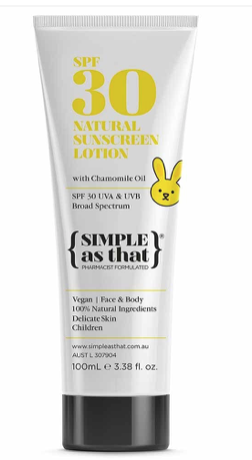SOS: Save Our Skin
- plant-terra
- May 11, 2020
- 4 min read
Updated: Sep 4, 2020
Summer is upon us, and with beaches beckoning and UV rays burning, it's time to dig out that sunscreen. Here's our pick of the best clean and eco-friendly sunscreens.

If, like me, you were blessed with the complexion of Nosferatu and spent any time growing up in Australia, there’s probably one product that has been a necessity in your daily life from childhood, and that is sunscreen.
Lately, I’ve been obsessing a little more than usual over sunscreen, scrutinising the ingredients list. If it’s something you wear on your skin every day, then it should be up for scrutiny, right? For the past few years I have been loyal to the sunscreen of a certain German cult skincare brand which markets itself as clean. Another brand I had been using markets itself as organic and ‘reef-friendly’, but when I took a closer look at the ingredients of both sunscreens I learnt all wasn’t as the marketing suggested. The labelling–and media– emphasised the natural, ‘organic’ ingredients of the sunscreens, and skimmed over the most important of all–the chemical UV filters.
Reef Friendly
My formerly beloved (and eye-wateringly pricey) sunscreen contained parabens such as methylparaben, ethylparaben, as well as avobenzone, homosalate, octinoxate (EWG hazard score of 6), and octisalate. These last four are common active chemical sun filters, and far from clean, despite the hype in fashion magazines and amongst influencers. Let that be a lesson: always do your own research.
Chemical sunscreens work by absorbing the sun’s UV rays which are then transformed by the chemical sun filters. They employ a potent combination of the aforementioned chemicals, as well as oxybenzone, and octocrylene. Oxybenzone is pernicious (it earns an 8 from the EWG) and is listed as a direct cause of coral bleaching— Hawaii has banned its sale and other US states are following suite. And if it’s in our oceans, then it’s also in marine life and seafood. Far from clean.
In your skin
Should you be concerned? Your skin is the largest organ of your body and because it is porous, it absorbs everything you put on it. Oxybenzone is such a widely used chemical filter—found in an estimated 60 percent of US sunscreens—that traces of it have reportedly been found in 97 percent of the U.S. population’s urine.
The ingredient is strongly suspected of being an estrogenic hormone disruptor. Hormone and endocrine disruptors mimic the hormones that our bodies create daily and can interfere with everything from our reproductive systems to our metabolism. In May 2019, the FDA confirmed that the “systemic absorption” of oxybenzone and other chemical filters from sunscreen exceeds the recommended threshold, which is particularly problematic for children.
Oxybenzone is such a widely used chemical filter—found in an estimated 60 percent of US sunscreens—that traces of it have reportedly been found in 97 percent of the U.S. population’s urine.
The EWG points out that in an evaluation of CDC-collected exposure data for American children, researchers found that adolescent boys with higher oxybenzone measurements had significantly lower total testosterone levels. Studies have now shown that once they’re in the bloodstream the chemicals “appear in concentrations above FDA’s toxicology threshold,” as reported by Wired, and remain at toxic levels for a full three days after application, which can also make its way into breastmilk.
Mineral vs Chemical Sunscreens
I sought to find the most effective and clean sunscreen currently on the market, which led me to mineral sunscreens or sunblock. Mineral sunblocks use zinc oxide or titanium dioxide which sits on top of the skin, deflecting or blocking UVA and UVB rays. Their effectiveness is immediate and their duration longer. They’re also a better option for people who have sensitive skin.
The downside is that mineral sunblock can be thicker and greasier and often leave a white cast on skin, resulting in a corpse look on darker skin tones. You probably remember them from childhood as thick, white, chalky zinc sticks which make you look like an Aussie cricketer. Finding one that was easy to wear and not pasty was an ordeal. Fortunately, there are many great mineral sunblocks on the market that are non-toxic, vegan and cruelty-free, and suit every budget and skin type.
I tried them all, and used my family—with their array of skin tones— as guinea pigs. I've looked for active ingredients which list zinc and/or titanium dioxide only, and avoided sunscreens that are labelled ‘mineral-based’ and are mixed with chemical UV blockers. An SPF factor of at least 30 was a must, with broad spectrum protection from both UVA and UVB rays, and water resistance was also a factor (most will be water resistant up to 80 minutes). Most importantly, they are reef-friendly, cruelty-free and kind to your skin.
For more information on sunscreen chemicals visit the EWG website at:
Read more about clean beauty here.
10 Clean Sunscreens for Surf, Sun + City
1. Nuori Mineral Defence Sunscreen SFP30 (V) 2. de Mamiel Atmospheriques SPF30 (V)
5. REN Clean Screen Mineral SPF30 (V) 6. Pai Skincare Hello Sunshine SPF30 (V)
7. Seventy-One Percent Eco Sun Shield SPF50+ 8. Vive Sana Daily Protezione SPF30 9. Simple As That Natural Sunscreen for Children SPF30 (V) 10. SunButter SPF50 Natural Sunscreen (V)
*(V) = Vegan





















Comments